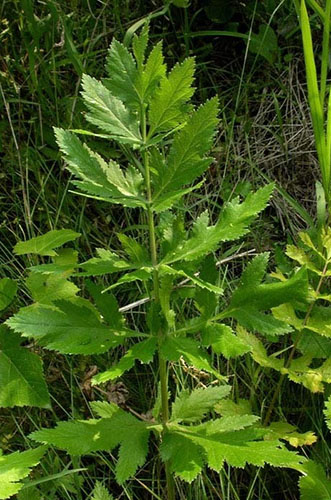Invasive Watch: Wild Parsnip
Wild parsnip, acts as a biennial weed, and inhabits roadsides, pastures, field edges or natural areas
Wild parsnip, acts as a biennial weed, and inhabits roadsides, pastures, field edges or natural areas
Wild parsnip acts as a biennial, forming a rosette of basal leaves the first year, overwintering and flowering in the second year. The basal rosette consists of large, pinnately compound leaves that resemble celery leaves.
 Photo Credit : Patrick J. Alexander, hosted by the USDA-NRCS PLANTS Database
Photo Credit : Patrick J. Alexander, hosted by the USDA-NRCS PLANTS DatabasePlants grow up to 6 inches in the rosette stage. Sharply toothed or lobed, egg-shaped leaflets run along both sides of a common stalk. The lower leaves have leaf stalks (petioles), where the upper leaves attach directly to the stem. The hollow, deeply grooved stem can grow 2 to 5 feet tall.
Flat-topped, broad flower clusters bloom from June through late summer. Five-petaled flowers are small, predominantly yellow and arranged in an umbel spanning 2 to 6 inches. Seeds are small, flat, slightly ribbed and straw-colored.
Plant parts contain a substance called psoralen, which can cause a condition known as phytophotodermatitis. A reaction occurs when plant juice gets on the skin and the skin is exposed to sunlight, which causes the skin to redden, develop a rash and, in severe cases, blister or burn. Dark red or brownish skin discoloration develops where the burn or blisters first appeared and can last for several months.
Wild parsnip inhabits roadsides, pastures, field edges or natural areas. It favors calcareous soils and sunny areas, but adapts to different environments. It can be found throughout most of the United States and Canada.
Wild parsnip produces a large amount of seed, which contributes to the plant’s persistence and spread. Seeds take three weeks to ripen before they can reseed, but they are viable in the soil for up to four years.
To effectively treat wild parsnip, apply Opensight® herbicide at 2 to 3.3 ounces per acre to the vegetative stage prior to bloom. Use the higher rate when weeds are larger. The goal is to eliminate seed production. Because flowering does not occur all at once, the area must be monitored for several weeks.
Connect with Vegetation Management:

™®Trademarks of Dow AgroSciences, DuPont or Pioneer, and their affiliated companies or their respective owners. When treating areas in and around roadside or utility rights-of-way that are or will be grazed, hayed or planted to forage, important label precautions apply regarding harvesting hay from treated sites, using manure from animals grazing on treated areas or rotating the treated area to sensitive crops. See the product label for details. State restrictions on the sale and use of Capstone, Milestone and Opensight apply. Consult the label before purchase or use for full details. Cleantraxx and Vastlan are not registered for sale or use in all states. Contact your state pesticide regulatory agency to determine if a product is registered for sale or use in your state. Always read and follow label directions.
For over 30 years, Vistas® has covered strategies, trends and stories from across the Vegetation Management industry.